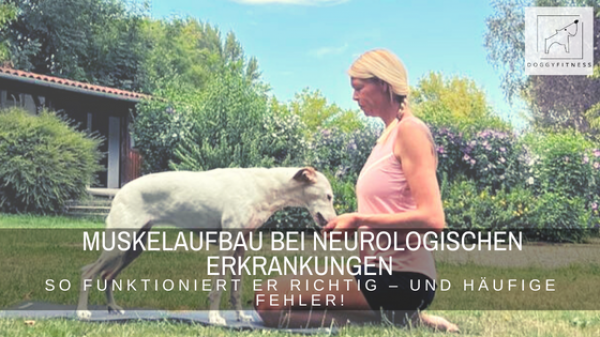Herniated discs, Cauda Equina Compression Syndrome, Wobbler Syndrome – these are just a few neurological conditions in dogs. Nowadays, we can not only diagnose them, but in many cases successfully treat them. Nevertheless, dog people contact me again and again who are completely desperate because their dog does not build up muscles despite intensive dog physiotherapy. In the exchange it turns out then in very many cases that the canine physiotherapeutic care regarding the movement training to strengthen the musculature again starts in the truest sense at the wrong end.
Let’s take a little digression for better understanding: How does muscle tension occur?
Simplified, muscle tension works as follows. In order for a muscle to actively tense (contract), information must be transmitted from the brain via the spinal cord, on to the nerve and finally to the muscle. The muscle must therefore be “prompted” by the nerve to contract/tension. So far so good. Then it should work well with the muscle development, because the dog is treated after a successful disc or cauda equina surgery at the dog physio, right? In principle, yes. The course was set surgically to release the compression of the nerves.
But why does it still not work? Muscle building for neurological diseases
Quite simple. In neurological diseases, for example, compression by intervertebral disc material or similar causes injury to the nerves. Here there is an interruption in the transmission of information from the brain via the spinal cord and the nerve to the muscle. The information for the muscle to tense cannot be passed on by the nerve, or only insufficiently. If you now simply try again and again to build up the muscles through pure strength training, you will fail.
The right treatment approach for muscle building & dog fitness training for neurological disorders.
In many neurological diseases, the prognosis is good that nerve function can be fully or largely restored. This can only be done by stimulating the nerves. So the first and most important step in this case is always to strengthen the nerve function. There are different ways to do this such as:
- Stroking out the spaces between the toes – extremely effective!
- Nerve stimulation through cold stimuli
- Stimulation of the nerves by massage with the massage glove or brush massage.
Proper strengthening of the nerve function in dog fitness / exercise training for dogs.
In active movement training it is very important to work with stimulating surfaces. These can be, for example, targets with knobs on which the exercises are performed. Furthermore, you can use for this purpose, for example, coconut mats or rubber mats. Outside, it is helpful to let the dog run regularly over changing surfaces, such as grass, forest floor, leaves, sand, moss, pebbles, etc…. This leads to an intensive stimulation of the nerves and consequently to a strengthening of the nerve function and an improvement of the nerve conduction. Muscle building for neurological diseases
As a dog person, you can do most of these yourself with your dog. Preferably always in consultation with the treating therapist. Along with a gradual improvement in nerve function, the musculature can then also be rebuilt.
Have you had any experience with muscle development not working for your dog after a neurological condition? Feel free to share your experiences with us in the comments!
All the best, your Tina Muscle building in neurological diseases
Dieser Beitrag ist auch verfügbar auf:
Français (French)
Deutsch (German)
Español (Spanish)
















